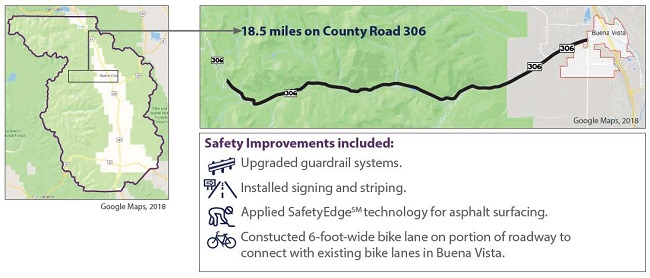U.S. Department of Transportation
Federal Highway Administration
1200 New Jersey Avenue, SE
Washington, DC 20590
202-366-4000
NOTEWORTHY PRACTICE
PDF Version [2.4 MB]
You will need the Adobe Reader to view this PDF.

When Colorado Department of Transportation (CDOT) learned the State had triggered the High Risk Rural Roads (HRRR) Special Rule (SR) in 2017, the agency identified an innovative way to obligate its HRRR funds.
In 2017, CDOT, Chaffee County, and the Federal Highway Administration (FHWA) Central Federal Lands Highway Division (CFLHD) joined forces with a common goal of improving safety along County Road 306, which is a curvy, high mountain pass road in south-central Colorado. Classified as a rural local road, County Road 306 carries less than 2,000 vehicles per day, with portions of the road closed during the winter season.
Chaffee County had received a Federal Lands Access Program grant and was collaborating with FHWA-CFLHD on a roadway improvement project for County Road 306. Meanwhile, CDOT staff had also been working with Chaffee County on ways to fund safety improvements along the county road. When CDOT data analysts reviewed the crash history and crash patterns along County Road 306, the results indicated roadway departure crashes were common. CDOT analysts confirmed that implementing low cost countermeasures and safety strategies (signing, striping, and guardrail improvements) could reduce these types of crashes by 20 percent and result in a benefit cost ratio of 1.56, exceeding Colorado's typical benefit cost threshold for safety improvement projects.
Initially, CDOT thought Highway Safety Improvement Program (HSIP) funds could be the solution; however, in 2017, FHWA notified CDOT that the HRRR SR would apply to Colorado in fiscal year 2018, which required CDOT to obligate a certain amount of funds to HRRR1 in the State. CDOT realized the project on County Road 306 presented a perfect opportunity for obligating HRRR funds. CDOT's regional and headquarter staff worked with the FHWA Colorado Division Office to transfer HRRR funds to FHWA-CFLHD to fund the safety improvements. FHWA-CFLHD administered the project on County Road 306 in ooperation with Chaffee County, the U.S. Forest Service, Pike National Forest, and San Isabel National Forest. The project was completed in the Summer of 2019.
David Swenka, CDOT's Safety Programs and Analysis Engineer, stated that, overall, the project was an example of innovative partnering efforts and successful collaboration to improve safety and help reduce crashes along a high risk rural road. CDOT plans to evaluate the project's effect on safety when more years of after-crash data are available. CDOT understood the value of matching a problem to a solution and found an innovative way to apply HRRR SR funds and save lives.
Overseen by FHWA-CFLHD, the project on County Road 306 included roadway rehabilitation and resurfacing funded by the Federal Land Access Program grant, as well as safety improvements made possible by HRRR SR funds.
Chaffey County, Colorado

1 FHWA Office of Safety Programs, Highway Safety Improvement Program, High Risk Rural Roads. Available online at: https://safety.fhwa.dot.gov/hsip/hrrr/.
Source: Information provided by David Swenka, Colorado Department of Transportation.


FHWA-SA-19-035
